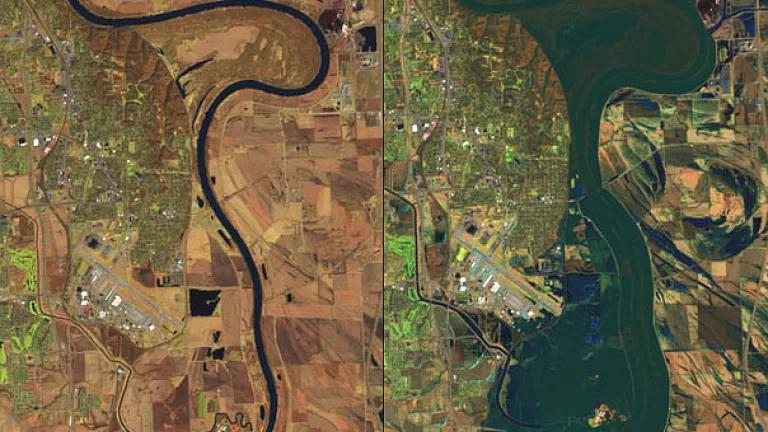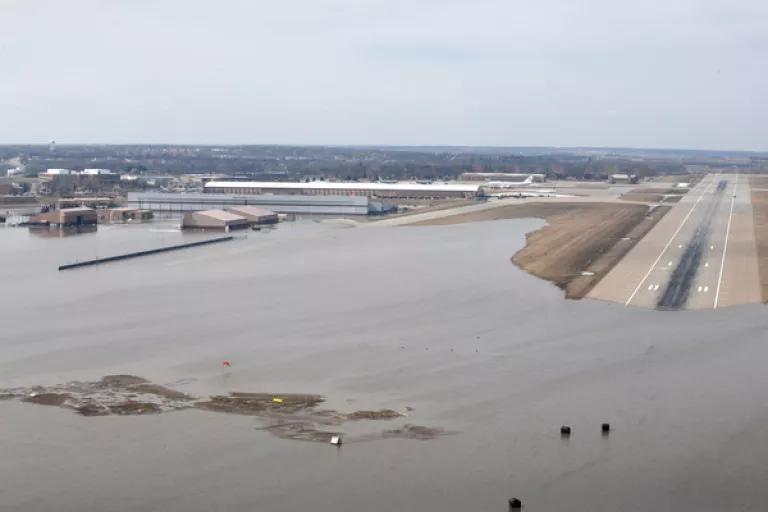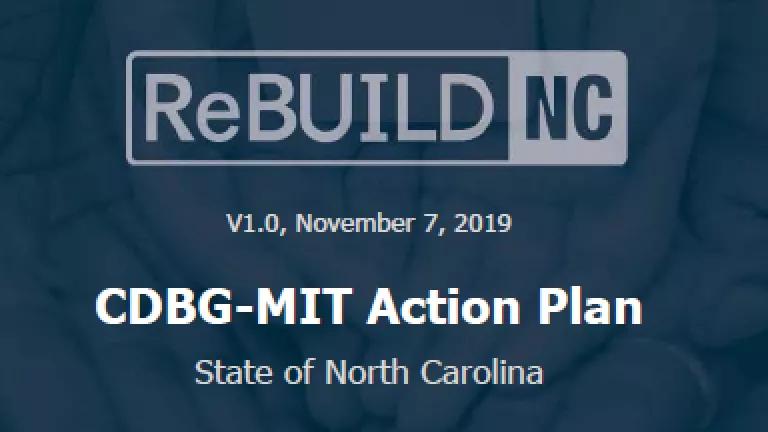Midwest Floods of 2019—The Latest Disaster to Learn From

The catastrophic flooding in Nebraska and other states along the Missouri River has brought back painful memories of major floods like those in 1993 and 2011. We know that floods are becoming more frequent and causing far more damage. The National Climate Assessment has warned that floods are more likely to occur in the Midwest as the climate changes. Bill McKibben, in an interview with ThinkProgress.com, pointed out that Nebraska’s “current trauma is part of everyone’s future.”
The flooding in the Midwest is the latest in a long line of catastrophic disasters that have climate change’s fingerprints all over them. While inland states suffer many more flood disasters than coastal states, they are more localized and usually don’t grab the national spotlight, unless they rise to the level of calamity now being seen in Nebraska, Iowa, and Missouri. Most people recall the names of Hurricanes Harvey, Irma, Maria, Florence, and Michael while major inland floods tend to quickly fade from the nation’s collective memory.
Since 2015, some of the nation’s biggest flood disasters have not resulted from hurricanes and tropical storms. They have occurred miles inland in central Louisiana (2016, $10.6 billion in losses), Houston (2016, $2.8 billion), Texas and Oklahoma (2015, $2.7 billion), Texas and Louisiana (2016, $2.4 billion), and South Carolina (2015, $2.2 billion). Even among recent hurricanes—Harvey and Florence in particular—historic levels of rain caused far more damage inland, compared to storm surge or high winds along the coastline. The damages from the 2019 floods are still being tallied, but are expected to exceed $1.3 billion in Nebraska alone and, as of this writing, the floodwaters are still moving downstream towards St. Louis.
Record disaster years have led to a growing recognition that we need to better prepare for and rebuild differently, not to mention adapt to the impacts of climate change. For flooding, attention is often focused on areas where “named storms” (i.e., hurricanes) have wreaked havoc or on coastal cities slowly being overtaken by sea level rise. Sometimes overlooked are the inland areas that are struggling with the increasing frequency and severity of flood disasters; like what’s now happening in Nebraska, Iowa, and Missouri. Our national memory does not always recall these “non-named” disasters as time passes.
The tragic flooding and resulting damage, trauma, and loss of life that communities are experiencing demand that the nation take long-overdue actions to avoid these types of tragedies in the future. In order to help those who will spend the coming months and years recovering from the Midwest Floods of 2019, the nation needs to move swiftly on the actions below.
Reinstate Federal Flood Protection Standards
President Trump rescinded federal flood protection standards just days before Hurricane Harvey, a major misstep that grows increasingly damaging with each passing flood disaster. The Trump administration said it would propose a new standard, but that has proven to be an empty promise. Federal flood protection standards would ensure that public areas are sited and designed with an additional margin of safety for future flooding and sea level rise. Congress could put a federal flood protection standard back in place and there’s interest in doing just that.
Help People Move to Higher Ground
A growing number of Americans are tired of being flooded repeatedly and they need assistance to move to higher ground. Unfortunately, that can be hard to come by, as government disaster assistance usually prioritizes rebuilding in the same vulnerable place. Owners of these homes are, in a sense, trapped by the disaster aid programs designed to enable rebuilding. We need to make it far easier for flood disaster survivors to get assistance to move to higher ground when they would prefer to do so. Congress has requested that the Government Accountability Office find out why buyouts and relocation efforts are so inefficient and time-consuming. And NRDC has called for making buyouts of flood-prone homes a benefit of flood insurance coverage.
Reform the National Flood Insurance Program
The National Flood Insurance Program (NFIP) should be a linchpin in the nation’s efforts to prepare for and recover from flood disasters, but in its current state it’s a liability, especially when you factor in the growing influence of climate change. The NFIP not only provides insurance to millions of Americans, it is also responsible for mapping flood risks, establishing minimum development standards for the nation’s floodplains, and is a primary source of flood risk information. In every aspect of the program, it fails to deliver what’s needed. NRDC has long called for climate-smart NFIP reforms that include:
- Helping people move to higher ground – The NFIP could directly provide funding to help people who live in flood-prone homes to move out of harm’s way, but it doesn’t. For the majority of the most flood-prone homes in the NFIP, NRDC has found it would be cost effective to provide this assistance and help thousands of people relocate now—and help many more in the future.
- Increase transparency and require disclosure of flood risks – If people are denied access to information, they cannot avoid buying or renting a home in a place that’s at high risk of flooding. Congress should
- require past flood damages and other information be disclosed to homebuyers and renters (28 states currently have inadequate or no disclosure requirements at all),
- require that homeowners have a right to know about past flood damage claims paid by the NFIP or private insurers, and
- require FEMA to publish much more of the data it collects through the NFIP, most of which is kept out of public view.
- Produce flood maps that reflect future conditions and climate change – FEMA’s flood maps do not take into account how flooding will get worse in the future due to incidents of extreme weather, sea level rise, and other factors. As a result, the potential for larger floods, like those affecting Nebraska and the Midwest, and those that the National Climate Assessment says are in the future, are not accounted for on official flood maps used for making development decisions.
Implement Resilience Provisions of the National Defense Authorization Act
Flooding in Nebraska has caused substantial damage to Offutt Air Force Base, the headquarters for Strategic Air Command. This is the third major military installation heavily damaged by floods and hurricanes in the past year. Last year, Camp Lejeune in North Carolina, the largest Marine Corps base in the world, was hit hard by Hurricane Florence, and Tyndall Air Force Base in Florida was leveled by Hurricane Michael. It would be laughable that President Trump questions the national security implications of climate change, given these damages, if he were not so dangerously off-base. Last year Congress directed the Department of Defense to pursue a suite of actions to ensure military bases were prepared for the impacts of climate change. In light of the damage military bases have sustained recently, that looks like a pretty smart move.
The Center for Climate and Security highlighted some of those actions, which include:
- “Floodplain requirements on new military construction (roughly $10 billion annually): Projects must identify whether they are in the 100-year floodplain, and if so, they must not only include mitigation plans, but be designed to assume an additional 2 feet above the base flood elevation (3 feet for mission critical facilities). This was originally a bipartisan stand-alone bill introduced by Senators Schatz, Moran, and Reed. (Sec 2805)
- “Inclusion of energy and climate considerations into installation master plans (which govern how a base is laid out and where new construction will occur). (Sec 2805)
- “Authority to expend Readiness and Environmental Protection Initiative funds to protect military installation resilience (Sec 312i)
- “Expanding Defense Access Roads authority to improve critical roads outside a base that are impacted by sea-level rise and recurrent flooding. (Sec 2865)”





